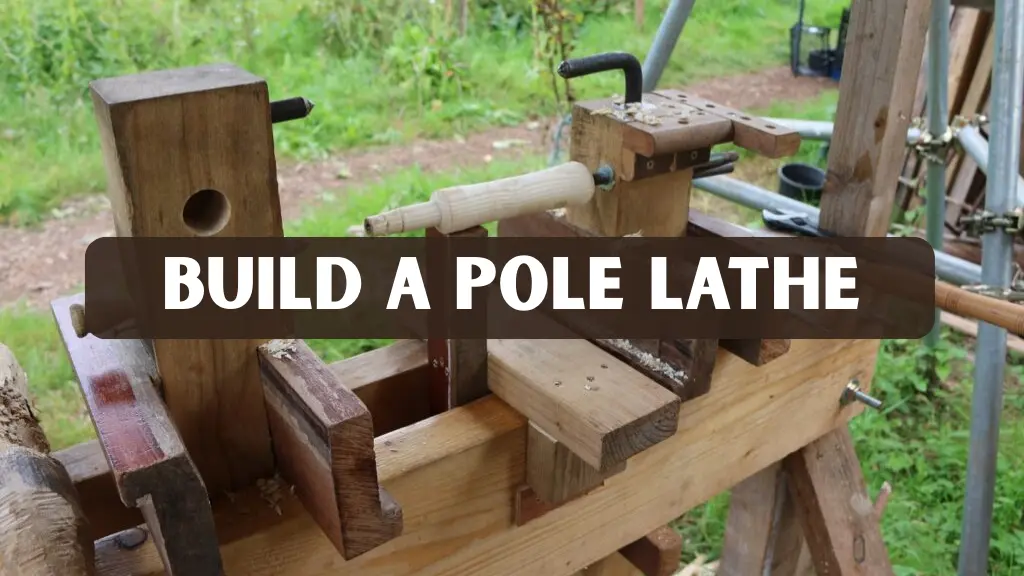A Pole Lathe is one of the oldest tools in woodworking history. For centuries, artisans have relied on it to shape green wood into both functional and decorative items. Unlike modern electric lathes, this tool operates entirely on human power, fostering a unique connection between the woodworker and the material. It enables craftsmen to create chair legs, spindles, bowls, tool handles, and other wooden components with precision and artistic detail.
This guide provides a comprehensive overview of the history, construction, techniques, and maintenance of this traditional woodturning tool. By combining insights from experienced woodworkers with practical tips, it offers valuable information for both beginners and seasoned artisans. Readers will gain an understanding of how to work safely and effectively, preserving time-honored methods while producing high-quality, handcrafted wooden pieces.
Understanding Pole Lathe
A pole lathe operates through a simple reciprocating motion powered by a foot treadle and a spring pole. Pressing the treadle rotates the workpiece forward, while releasing it allows the spring mechanism to return the wood in the opposite direction. This back-and-forth movement gives the woodworker precise control over shaping, especially when working with green wood. The lathe provides a unique experience compared to electric lathes, as it requires synchronization between the feet operating the treadle and the hands controlling the cutting tools.
The essential components include the lathe bed, poppets, spring pole, treadle, and spigots or centers. The lathe bed provides a stable foundation, while poppets hold the workpiece securely. The spring pole generates the tension required for the reciprocating motion, and the treadle allows the woodworker to power the rotation. Spigots or centers secure the ends of the workpiece, ensuring even turning and precise shaping.
Historical Significance of Traditional Woodturning
This traditional woodworking tool has a long and storied history, particularly in Europe. In England, chairmakers known as bodgers often worked in forests, crafting chair legs and spindles directly from freshly felled timber. This approach, called green woodworking, allowed artisans to shape wood more efficiently than with seasoned timber. Bodgers typically set up temporary workshops with minimal tools, producing high-quality furniture components that were both functional and visually appealing.
During the 19th century, the rise of steam and electric-powered lathes reduced the use of foot-powered lathes in industrial settings. Nevertheless, these traditional tools remain popular among modern woodworkers who value heritage techniques and sustainability. They allow artisans to create pieces that machines cannot replicate, offering a tactile, hands-on, and creatively fulfilling woodworking experience.
Tools and Materials Needed for Woodturning
Before constructing or using a traditional woodworking lathe, it is important to gather the right tools and materials. Experienced woodworkers recommend using a drawknife for rough shaping, which removes bark and forms a basic cylinder. Gouges and chisels are essential for detailed shaping and finishing. A shave horse provides a stable, foot-powered clamping surface, while a mallet helps strike chisels or make fine adjustments. Drills or braces can create precise holes, and saws cut timber to the correct length efficiently.
Green hardwoods such as ash, oak, or sweet chestnut are ideal because of their flexibility and ease of shaping. A flexible sapling or modern bungee cord can serve as the spring mechanism, ensuring smooth rotation of the workpiece. Durable rope or cord connects the treadle to the spring, and metal rods or spigots secure the ends during turning. Woodworking experts emphasize that straight-grained hardwood for the lathe bed and poppets ensures stability, durability, and precision, preserving traditional craftsmanship.
How to Build Traditional Pole-Operated Lathe
Constructing a lathe begins with selecting a sturdy piece of timber for the lathe bed, typically around one to 1.2 meters long. The bed must be flat and level to ensure accurate turning. A central slot is often cut to hold the poppets, which can be adjusted for different wood lengths. Poppets are vertical supports shaped from hardwood and drilled to accommodate pegs or rods, allowing the workpiece to be securely placed. Ensuring both poppets are of equal height is crucial for stability.
The spring pole provides the tension for the reciprocating motion, with one end attached to the lathe bed and the other to the treadle. Flexible saplings or bungee cords serve this function, and proper tension is key to smooth operation. The treadle, a foot-operated lever connected to the spring, rotates the workpiece forward. Metal rods or spigots secure the ends of the wood, keeping it stable and aligned during turning. Correct alignment and tension are essential for safety and quality results.
Before beginning to turn, green hardwood must be prepared using a drawknife and shave horse to shape the timber into a rough cylinder slightly longer than the distance between the poppets. Centering the workpiece on the spigots and adjusting the poppets ensures stability, as improper placement can cause wobbling, uneven shaping, or increased wear on tools.
During turning, the treadle is pressed to rotate the wood forward, and cutting tools are applied only on the forward stroke. Releasing the treadle allows the wood to return without cutting. This process is repeated gradually to shape the piece. Light, controlled cuts are critical, especially for beginners, progressing from rough shaping to detailed finishing as skills improve. Sharp, well-maintained tools increase efficiency, reduce effort, and enhance precision.
Popular Projects and Applications
These traditional lathes are versatile and can produce a wide range of items. Historically, chair legs and spindles were the most common products, often crafted in temporary forest workshops. Today, artisans also use this method to create bowls, cups, tool handles, and decorative wooden ornaments. The natural properties of green wood allow for detailed shaping and smooth finishes, resulting in pieces that are both functional and visually appealing. This hands-on technique gives woodworkers precise control over the final form.
Using this historical woodworking approach also promotes sustainable practices. Working with green wood reduces the need for energy-intensive drying, and the lathe requires no electricity to operate. By combining traditional methods, careful material selection, and precise technique, artisans can produce high-quality, long-lasting wooden items. Experts note that this approach not only preserves heritage craftsmanship but also encourages responsible and environmentally friendly woodworking.
Case Study Reviving Traditional Chairmaking
In 2022, a small woodworking studio in Somerset, England, called Heritage Woodcraft, embarked on a project to revive traditional green woodworking techniques using a pole lathe. The studio aimed to produce handcrafted chairs entirely from locally sourced green oak while preserving historical methods used by bodgers centuries ago.
The team built a custom lathe using hardwood timber, a flexible spring pole, and durable spigots. Each chair leg was turned on the lathe using a combination of drawknife and gouge, with artisans carefully controlling the forward stroke for precision shaping. The reciprocating motion required skill and coordination, but it allowed the woodworkers to produce smooth, consistent shapes without electricity.
Within three months, the studio produced 50 chair sets, each leg unique yet consistent in quality. Customers praised the tactile feel and craftsmanship of the furniture. Heritage Woodcraft reported that this traditional foot-powered woodworking method reduced waste because green wood is easier to shape and caused fewer errors compared to seasoned timber. This case study demonstrates that these historical woodturning techniques are viable for modern projects while providing sustainable, high-quality results that connect artisans to centuries-old craftsmanship.
Advantages and Limitations
The tool is environmentally friendly, operating completely without electricity and relying solely on human power. Its construction cost is low because most materials can be sourced locally or from timber offcuts. Manual operation is slower than electric lathes, and mastering the forward stroke takes patience and practice. Green wood is preferred as it is easier to shape, while dry timber can be more difficult and may dull tools faster. Extended work sessions can be physically demanding, requiring foot coordination and stamina.
A major advantage of this traditional woodworking method is its strong connection to historical craftsmanship. It allows woodworkers to achieve precise control while engaging directly with the material. Hands-on operation develops fine motor skills and attention to detail, which are essential for quality work. Experts highlight that this approach preserves time-honored techniques and encourages sustainable practices. For artisans, the experience is creatively fulfilling and provides a meaningful link to woodworking history.
Maintenance and Safety Considerations
Maintaining a pole lathe is essential for longevity and safe operation. Sharp tools are critical for clean, precise cuts and reducing risk of damage to the wood or lathe. Experienced woodworkers recommend inspecting cords, spigots, and the lathe bed regularly for wear, cracks, or misalignment. Properly adjusted spring tension ensures smooth motion and prevents uneven rotation that could damage the workpiece or cause accidents.
A safe workspace is also crucial. Woodturners should work in well-lit areas and keep the floor clear of obstructions. Protective gear, such as safety glasses and gloves, prevents injuries from flying wood chips or misaligned tools. Following these best practices ensures thelathe performs reliably and safely.
Conclusion
A pole lathe represents centuries of woodworking tradition, connecting artisans to historical methods while allowing for creative and precise craftsmanship. With proper preparation, tools, and techniques, woodworkers can build and operate this traditional lathe to produce chair legs, bowls, tool handles, and decorative items. Regular maintenance, attention to safety, and consistent practice ensure this centuries-old tool continues to provide a rewarding woodworking experience. For further guidance on wood types, properties, and techniques, visit The Wood Database.
Frequently Asked Questions
What is a Pole woodturner used for?
A pole woodturner is used for shaping green wood into functional and decorative items such as chair legs, spindles, bowls, and tool handles. Its reciprocating motion allows for precise control and smooth cutting.
Is it possible to turn dry wood on a pole-driven woodturning tool?
While possible, dry wood is more challenging to shape and may dull tools faster. Beginners are advised to start with green wood.
Is a workshop necessary to operate the lathe?
No. A well-lit area with sufficient space to operate the treadle is sufficient. Outdoor setups are often used, especially in traditional woodworking.
How do I properly care for and maintain a lathe?
Keep tools sharp, inspect cords and spigots regularly, and adjust spring tension for smooth operation. Stability is essential for safety and quality.
Can I build a DIY woodworking lathe myself?
Yes, many woodworkers construct their own lathes using timber, flexible poles or cords, and spigots. Plans and tutorials are widely available online.




